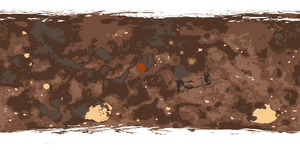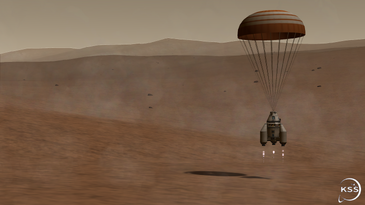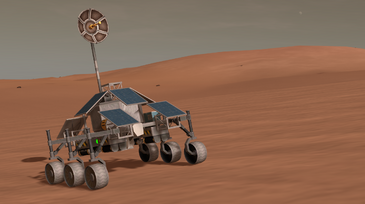Duna is the fourth planet from Kerbol and the second smallest planet in the Kerbol system, after Moho. Named after an ancient god of war, it is often referred to as the "Red Planet" due to the iron oxide prevalent on its surface which gives it a reddish appearance. Duna is a terrestrial planet with a thin atmosphere, having surface features reminiscent both of the impact craters of the Mun and the valleys, deserts, and polar ice caps of Kerbin.
In-game Description
"Also known as the red dot that you can see if you squint at it really hard, Duna has long been a wonder to Kerbalkind. The planet has been held in much awe due to its striking red color and stark contrast to the color green."
Physical Characteristics
The rotational period and seasonal cycles of Duna are likewise similar to those of Kerbin, as is the orbital tilt that produces the seasons. Duna is the site of Kilanus Mons, the largest volcano which is believed to be the second highest known mountain in the Kerbol System. It is also home to the Valles Karineris, one of the largest canyons in the Kerbol System. The smooth Korealis basin in the northern hemisphere covers roughly 40% of the planet and it is unknown if it may be a giant impact feature. However, it is very likely to have once hosted an ancient ocean that has long dried up. A Duna year takes 801 days, 3hrs and 50 mins to complete and a Duna day lasts 1.025 Kerbin days, or roughly 6 hours and 9 minutes.
Duna has two moons, Bop and Gilly, which are small and irregularly shaped. These may be captured asteroids, but theories as to the origins of the two Dunian moons remain unproven.
Of all the planets in the Kerbol system, it is the one which most closely resembles Kerbin in its ability to sustain life (except for Tropical Laythe, if installed).
Atmosphere
Duna's atmosphere retains a mere six-hundredth of the pressure of Kerbin's atmosphere at sea level, and is known to contain 95% carbon dioxide, 2% nitrogen, and an assortment of trace gases such as water vapor.
Climate
Duna's present climate is dry and cold, with a mean temperature of 210 Kelvin (-63 degrees Celsius). However, the temperature at the equator (and at low altitudes) of Duna occasionally reach above the melting point of water, allowing small streams of groundwater to form. Small channels on Duna's surface have been known to form this way.
The heavy/light water ratio found in the ice caps and lithosphere of Duna suggests that the planet had a much wetter past, one where a long standing ocean may have existed on the surface and drove global air currents in a thicker, warmer atmosphere.
Orbit - Rotation
Duna's orbit places it near the outer edge of Kerbol's liquid water habitable zone (HZ). The eccentricity is greater than that of every other planet except Moho and the orbit is inclined by 1.85 degrees. Seasons on Duna last twice as long as on Kerbin. The temperature differences caused by the orbital distance can trigger sandstorms.
Moons
Possibilities of Life
As mentioned earlier, Duna is the most Kerbin-like world in its abilities to sustain life (besides tropical Laythe, if installed). Before high-definition imagery had been focused on Duna, Kerbals dreamed of tall pink men walking around the surface. Now, imagery of Duna has convinced Kerbals that it is a dead world. However, close investigations have revealed channels likely formed from past outflows of water on the surface. It is believed, if a Kerbal gets lucky, they may find evidence of life on Duna. In the future, as Kerbol's habitable zone expands, Duna may breifly become more temperate and could even support life. However, this period will probably be tragically short as Kerbol continues to expand.
Biomes
Duna has 11 biomes:
- Ice Caps
- Prominent Impact Craters
- Old Water Basins
- Lowlands
- Midlands
- Highlands
- Valles Karineris
- Volcanoes
- Kilanus Mons
- Peaks
- Living Soil

Gallery

First Manned Landing on Duna.

A rover exploring the surface of Duna

A small probe landing on Duna.
Trivia
- Duna was likely once a lush Kerbin-like world, but through the process of solar wind lost its atmosphere, meaning its ability to host life.